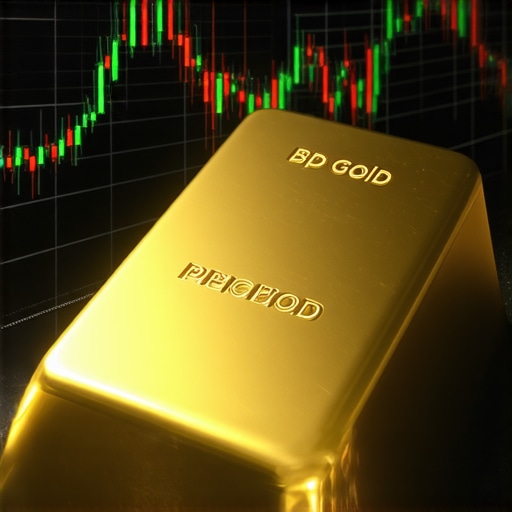Introduction to Gold Price Trends
Understanding gold price trends is crucial for investors looking to navigate the complex world of precious metals. Gold has long been considered a safe haven during economic uncertainty, which makes it vital for investors to grasp the factors that influence its price fluctuations. Whether you are a seasoned investor or just starting, knowing how to interpret these trends can significantly enhance your investment strategy.
Factors Influencing Gold Prices
The gold market is affected by a multitude of factors that can lead to price changes. Some of the primary drivers include:
Economic Indicators
Economic data such as inflation rates, employment figures, and GDP growth can heavily influence gold prices. For example, increased inflation often leads investors to flock to gold, driving up its price. Understanding these indicators can help investors anticipate potential price movements.
Geopolitical Events
Global events such as political instability, conflicts, or changes in government policies can create uncertainty, prompting investors to seek the stability of gold. Keeping an eye on current events can provide insights into possible price surges or declines. For more on how global dynamics affect investments, check out our article on Understanding Gold Demand Trends: A 2025 Outlook.
Currency Fluctuations
The strength of the U.S. dollar has a direct impact on gold prices. When the dollar weakens, gold becomes cheaper for investors using other currencies, driving up demand and consequently the price. Monitoring currency trends can provide valuable information for predicting gold price movements. For insights on currency impacts, refer to Navigating Gold Price Forecasts: Insights for Investors.
Understanding Market Sentiment
Market sentiment plays a significant role in gold price trends. Investor behavior, driven by fear or greed, can lead to rapid price changes. Tracking market sentiment indicators, such as the Fear and Greed Index, can help investors gauge the mood of the market and make informed decisions.
Technical Analysis
Utilizing technical analysis tools can offer additional insights into gold price trends. Chart patterns, moving averages, and volume indicators can help investors identify potential entry and exit points. Understanding these tools is essential for those looking to trade gold actively. For further reading on chart analysis, check our post on Gold Trading Techniques: Maximize Your Trade Success.
Conclusion
By grasping the key elements that influence gold price trends, investors can make more informed decisions and enhance their investment portfolios. Whether it’s through understanding economic indicators, geopolitical events, or market sentiment, staying informed is key to successful gold investment strategies.
Analyzing Gold Market Dynamics
To effectively understand gold price trends, investors must delve deeper into the dynamics that govern the market. Observing how various factors interact can provide valuable insights into future price movements. One significant aspect to consider is the correlation between gold prices and interest rates. As interest rates rise, the opportunity cost of holding gold increases, often leading to decreased demand. Conversely, lower interest rates tend to boost gold investments, as the metal becomes more attractive compared to non-yielding assets. For a detailed exploration of this relationship, check our post on Physical Gold Investments: Buying vs Storing.
The Role of Supply and Demand
Understanding the fundamentals of supply and demand is pivotal when analyzing gold prices. The availability of gold—whether through mining or recycling—can impact market prices significantly. For instance, if mining output decreases due to geopolitical issues or resource depletion, prices may surge as supply tightens. Investors should also consider the demand side, including jewelry, technology, and investment demand. For insights into how these factors interrelate, read our article on Understanding Gold Demand Trends: A 2025 Outlook.
Global Economic Conditions and Their Impact
Global economic conditions substantially affect gold prices. Economic downturns, for instance, often lead to increased gold buying as investors seek refuge from market instability. During such times, understanding global economic indicators—like unemployment rates, inflation, and consumer confidence—can help investors gauge gold’s potential performance. To learn more about how these indicators affect gold investments, explore our post on Effective Gold Investment Strategies for Smart Investors.
Seasonal Trends in Gold Prices
Seasonality also plays a role in gold price trends. Historically, gold prices tend to rise during certain times of the year, particularly during the wedding season in India, a major consumer of gold. Understanding these seasonal patterns can help investors time their purchases more effectively. For a comprehensive understanding of the best times to invest, check out our guide on The Best Gold Investment Strategies for Today’s Market.
Leveraging Advanced Analytical Tools
Investors looking to refine their strategies should consider leveraging advanced analytical tools. Tools such as moving averages, Fibonacci retracements, and RSI (Relative Strength Index) can help identify market trends and potential reversal points. For those looking to enhance their trading strategies, our article on Top Gold Trading Techniques to Enhance Your Strategy provides essential insights.
Staying Informed with Market News
Remaining updated with the latest market news is vital for any investor in the gold space. Alerts on major news events, central bank policies, and changes in economic indicators can provide early signals of price volatility. Subscribing to reputable financial news sources or market analysis reports ensures that you are always informed. For further insights on how to interpret market dynamics, read our post on Gold Market Analysis: Key Factors Influencing Prices.
Understanding Gold Investment Strategies
For investors seeking to maximize their returns, understanding effective gold investment strategies is crucial. Various methods can be employed, ranging from physical gold purchases to investing in gold ETFs or mutual funds. Each approach has its unique advantages and risks, making it essential for investors to evaluate their options carefully. For a comprehensive overview of these strategies, explore our guide on The Best Gold Investment Strategies for Today’s Market.
The Benefits of Gold ETFs
Gold exchange-traded funds (ETFs) provide an accessible way for investors to gain exposure to gold without the need for physical storage. These funds track the price of gold and can be bought and sold like stocks, offering liquidity and convenience. Investors interested in diversifying their portfolios might find ETFs an attractive option. Learn more about how to navigate this investment in our post on Unlocking Success with Gold ETFs: A How-To Guide.
Weighing the Risks vs. Rewards
While gold can serve as a hedge against inflation and economic instability, it is not without risks. Price volatility can lead to significant fluctuations in value. Investors must weigh these risks against potential rewards, especially when considering long-term versus short-term investment horizons. For insights into making informed decisions, check out Effective Gold Investment Strategies for Smart Investors.
Exploring Gold Demand Trends
Gold demand is influenced by a myriad of factors, including cultural significance, economic conditions, and technological advancements. In countries like India and China, gold plays a vital role in cultural practices, leading to increased demand during festive seasons. Understanding these trends can help investors predict potential price movements. For a deeper dive into how these dynamics shape demand, visit Understanding Gold Demand Trends: A 2025 Outlook.
The Influence of Jewelry and Technology
Jewelry remains one of the largest sectors driving gold demand. In addition to jewelry, gold is also used in various technologies, including electronics and medical devices. As technological advancements evolve, so too does the demand for gold in these sectors, making it important for investors to stay informed about industry trends. Our article on Spotting Gold Demand Trends: What to Anticipate delves into this topic further.
Gold Market Analysis: Understanding Price Fluctuations
Analyzing price fluctuations is a key component of successful gold investment. Factors such as geopolitical tensions, changes in monetary policy, and shifts in consumer preferences can all impact gold prices. Investors should regularly review market analyses to stay ahead of these developments. For a thorough examination of market forces, refer to our post on Gold Market Analysis: Key Factors Influencing Prices.
Utilizing Analytical Tools for Better Decisions
Investors can leverage various analytical tools to enhance their decision-making processes. Tools such as moving averages, Bollinger Bands, and market sentiment indicators provide insights that can guide trading strategies. For those looking to refine their approach, our guide on Gold Trading Techniques: Maximize Your Trade Success covers essential strategies that can improve investment outcomes.
Advanced Gold Investment Strategies
As the gold market evolves, investors must adapt their strategies to maximize returns. Beyond basic investment principles, advanced strategies can help investors navigate complex market conditions. These strategies include options trading, utilizing leverage, and diversification through various gold assets.
Options Trading in Gold Investments
Options trading offers investors the flexibility to speculate on gold price movements without directly buying the asset. By purchasing call or put options, investors can benefit from price fluctuations while managing risk. This strategy is particularly useful in volatile markets. For a deeper understanding of options trading and its benefits, read our article on Gold Trading Techniques: Expert Tips for 2025 Prospects.
Leveraging Gold Investments
Using leverage can amplify potential returns in gold investments, allowing investors to control larger positions with a smaller capital outlay. However, this approach comes with increased risk, as losses can also be magnified. It’s crucial to have a solid understanding of risk management techniques when employing leverage. For more insights on effective gold investment strategies, check out Effective Gold Investment Strategies for Smart Investors.
Diversification and Gold Assets
Diversifying within the gold sector is a prudent strategy for investors looking to mitigate risk. This can be achieved by investing in a mix of physical gold, gold ETFs, and mining stocks. Each type of investment carries different risk profiles and potential rewards. Understanding these differences can help investors tailor their portfolios to their risk tolerance and investment goals.
Physical Gold vs. Gold ETFs
Investing in physical gold involves purchasing coins or bullion, which can be stored securely. This method provides a tangible asset but also comes with storage and insurance costs. In contrast, gold ETFs offer a more liquid investment option without the need for physical storage. For a comprehensive guide to navigating gold ETFs, visit Unlocking Success with Gold ETFs: A How-To Guide.
Mining Stocks as an Investment Option
Investing in gold mining stocks can provide exposure to gold prices while also benefiting from the operational efficiencies of mining companies. However, these stocks can be influenced by additional factors such as management decisions and operational costs. For those interested in exploring mining stocks, our article on Comparing Gold Investments: Stocks vs. Bullion Explained offers valuable insights.
Conclusion: Mastering Gold Investment Strategies
By understanding and implementing advanced gold investment strategies, investors can enhance their potential for success in the dynamic gold market. Whether through options trading, leveraging investments, or diversifying across various gold assets, a well-structured approach can lead to better financial outcomes. Staying informed and adapting to market changes is essential for long-term success in gold investments.
Frequently Asked Questions about Gold Investment
1. What are the main factors that influence gold prices?
Gold prices are influenced by various factors such as economic indicators (inflation, employment rates), geopolitical events (political instability), currency fluctuations (impact of the U.S. dollar), and market sentiment (fear or greed among investors).
2. How can I invest in gold?
Investors can invest in gold through several methods, including purchasing physical gold (coins or bullion), investing in gold exchange-traded funds (ETFs), or buying shares in gold mining companies.
3. What are gold ETFs and how do they work?
Gold ETFs are investment funds that track the price of gold and can be traded on stock exchanges. They offer a convenient way for investors to gain exposure to gold without needing to physically store it.
4. How does inflation affect gold prices?
During periods of high inflation, gold is often seen as a safe haven asset. As the value of currency decreases, investors tend to flock to gold, driving up its price. Understanding inflation trends can help investors anticipate gold price movements.
5. Are there risks associated with investing in gold?
Yes, while gold is considered a safe haven, it is not without risks. Price volatility can lead to significant fluctuations in value, and investors must carefully assess their risk tolerance before investing.
6. What is the best time to buy gold?
The best time to buy gold can vary based on market conditions, but historically, gold prices tend to rise during certain seasons, such as wedding seasons in India. Monitoring market trends is essential for timing purchases effectively.
7. How can I perform technical analysis on gold investments?
Technical analysis involves studying price charts and using indicators like moving averages and the Relative Strength Index (RSI) to identify trends and potential entry or exit points for gold investments.
8. What are mining stocks and how do they relate to gold investment?
Mining stocks are shares of companies that extract gold from the earth. Investing in these stocks provides exposure to gold prices while also depending on the operational success of the mining companies.
9. How does geopolitical instability impact gold prices?
Geopolitical instability often leads to increased demand for gold as a safe haven asset. Investors tend to seek stability during uncertain times, which can drive up gold prices significantly.
10. How can I stay informed about gold market trends?
Investors can stay informed by subscribing to financial news outlets, following market analysis reports, and utilizing resources that provide insights into economic indicators and gold market developments.
Authority Resources for Gold Investment
For those looking to deepen their understanding of gold investment strategies and market analysis, the following trusted resources are recommended:
- World Gold Council – A leading authority on gold, providing insights into market trends, demand, and investment strategies.
- Investopedia – Offers comprehensive articles and educational resources on gold investments and market analysis.
- Kitco – A reliable source for real-time gold prices, market news, and expert analysis.
- Bloomberg – Provides up-to-date financial news and data, including gold market insights.
- MarketWatch – Features news and analysis on various investment markets, including gold.
- CNBC – A leading financial news network covering market trends and investment strategies.
Conclusion: Navigating the Gold Investment Landscape
Mastering gold investment strategies requires a thorough understanding of market dynamics, economic indicators, and personal investment goals. By leveraging advanced analytical tools, staying informed through reliable resources, and adapting to market changes, investors can effectively navigate the complexities of gold investments. Whether you choose physical gold, ETFs, or mining stocks, a well-rounded approach will enhance your potential for success in the gold market.










I’ve recently started investing in gold and found it to be incredibly fascinating how various factors can influence its price movements. The section discussing economic indicators was particularly enlightening for me. I never fully appreciated how closely tied gold is to interest rates until I read your explanation. The inverse relationship makes a lot of sense; when rates are low, gold becomes a more appealing alternative. Additionally, geopolitical events caught my attention; in times of uncertainty, I’ve noticed friends leaning toward gold as a secure investment. It’s interesting to consider how cultural factors, like the wedding season in India, can also drive demand significantly. The information on technical analysis tools, such as RSI and moving averages, really piqued my interest as well. I’m eager to start applying these strategies in my trades, especially to better analyze price movements. Overall, I’m motivated to keep learning about how market sentiment plays a role, too. Thanks for laying out such a comprehensive guide for us newbies!
Investing in gold has definitely opened my eyes to the broader market mechanics at play. I never considered how deeply the strength of the U.S. dollar impacted gold prices until now. It’s fascinating how a weaker dollar can lead to an influx of buyers from other countries, effectively driving prices up. Also, the insights about seasonal demand during events like weddings in India were eye-opening. I wonder how global cultural trends could continue to affect gold demand on a larger scale. Moreover, you pointed out that analyzing supply factors through mining output can often lead to unexpected shifts in price; if less gold is mined, that scarcity will likely bump prices up further. As someone who’s still developing my investment strategy, I appreciate the emphasis on staying informed with market news and understanding international events that could affect the market. It’s certainly a dynamic time for gold investment! I’m curious if others have integrated these tools with their own investment styles?